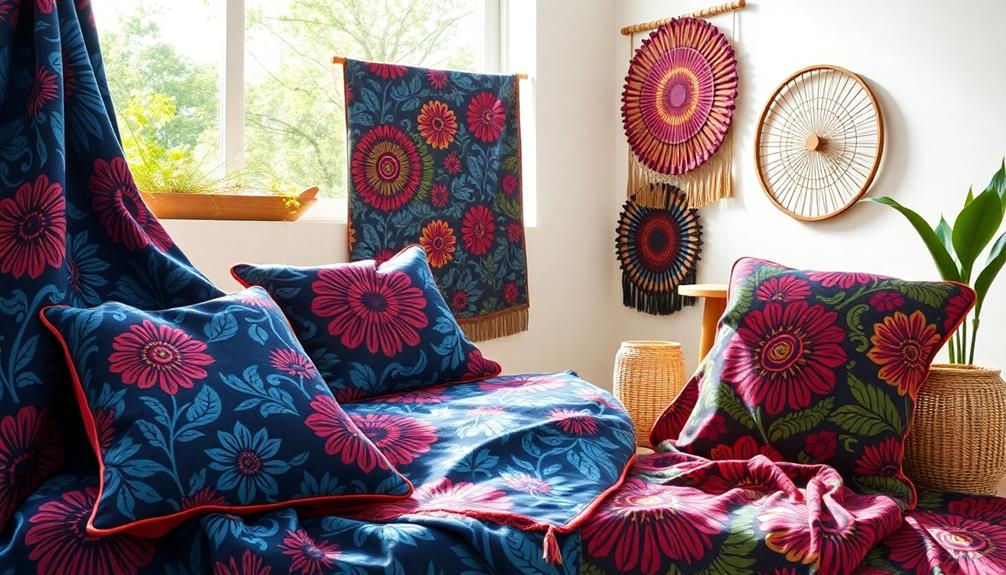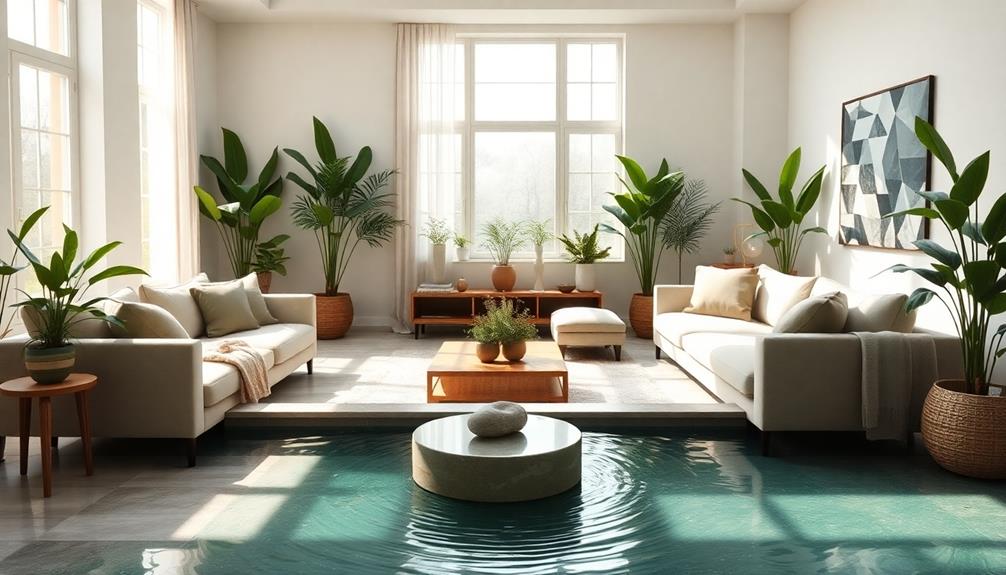Batik is the ultimate trend for your home design in 2024 because it brings together vibrant culture, historical significance, and unique artistry. Its wax-resist dyeing technique creates stunning patterns that add depth to any space. You can use batik in accent pillows, quilts, or wall art, seamlessly blending it with various styles, from bohemian to minimalist. As sustainability becomes essential in design, batik's eco-friendly production aligns with modern values. Plus, the stories behind traditional motifs resonate deeply, making your decor choices meaningful. If you're curious about how to incorporate this art form into your home, there's much more to explore.
Key Takeaways
- Batik's unique wax-resist dyeing technique offers intricate patterns that enrich home decor with vibrant colors and textures.
- The eco-friendly production methods of batik align with the growing consumer demand for sustainable design choices in home interiors.
- Contemporary adaptations of traditional batik aesthetics cater to modern tastes, making it a versatile option for various design styles.
- Incorporating batik into home decor not only enhances visual appeal but also connects spaces to a rich cultural heritage.
- The symbolic meanings behind batik motifs add depth and storytelling to decor, resonating with those seeking personalized design elements.
Understanding Batik

Batik is more than just a fabric; it's a vibrant art form with over 2,000 years of history. Utilizing a unique wax-resist dyeing technique, batik creates intricate patterns that stand out in any interior design setting.
You might be surprised to learn that each design often carries historical and symbolic meanings, reflecting a rich cultural heritage deeply rooted in Indonesian traditions. Additionally, batik shares similarities with other traditional Indonesian crafts, such as the Face Indonesian Decor Mask, which also emphasizes cultural storytelling through intricate designs.
When you explore batik, you'll discover various techniques, from Batik Tulis, which is hand-drawn, to Batik Cap, which is stamped, and Batik Lukis, painted. Each method showcases different levels of craftsmanship and artistic expression, allowing you to choose what resonates most with your style.
Incorporating batik into your home decor can bring a touch of elegance and history to your space. Whether it's through wall hangings, throw pillows, or table linens, these textiles not only enhance the aesthetic appeal of your interior design but also connect you to a global cultural heritage.
Historical Significance

The rich tapestry of batik's history reveals its profound significance beyond mere aesthetics. Originating over 2,000 years ago, batik has become intertwined with cultural identity, especially in Indonesia. Its historical significance isn't just in its beauty but in the stories woven into its traditional motifs, which can be seen in various forms of Indonesian decorative pillows that enhance living spaces.
These motifs often symbolize various aspects of life, such as:
- Social Status: Different patterns can indicate a person's rank or profession.
- Nature: Many designs reflect flora and fauna, showcasing the beauty of the natural world.
- Historical Events: Certain patterns are tied to significant events in local history, preserving collective memory.
Additionally, UNESCO recognizes batik as a crucial cultural heritage, underscoring its role in fostering community identity and artistry.
The evolution of batik techniques, like Batik Tulis and Batik Cap, highlights a tradition of craftsmanship that adapts while maintaining its roots.
Unique Characteristics

An intricate beauty defines batik, thanks to its unique wax-resist dyeing technique. This method enables artisans to create stunning, detailed patterns that are truly one-of-a-kind. When hot wax is applied to specific areas before dyeing, it results in distinct textures and vibrant color variations, making each piece of batik fabric a unique work of art.
The artistry of batik can be compared to the craftsmanship found in Indonesian decor masks, where traditional artistry reflects rich cultural narratives.
Traditional batik designs often carry symbolic meanings, rooted deeply in cultural and historical contexts. These patterns reflect the identity and heritage of the regions where they originated, adding layers of intrigue and significance to your decor.
As you explore batik, you'll appreciate how the oxidation process during drying creates natural variations, enhancing the individuality of every fabric.
Moreover, batik's versatility allows it to blend seamlessly into various interior design styles, from bohemian to modern aesthetics. This adaptability makes it a compelling choice for contemporary home decor, ensuring that regardless of your style, batik can elevate your space.
Embracing the unique characteristics of batik not only enriches your home but also connects you to a rich cultural narrative, making your living environment more meaningful.
Incorporating Batik in Interiors

Incorporating batik into your interiors can transform a space with its vibrant patterns and rich cultural heritage. The unique batik patterns can elevate your home decor, making each room a reflection of your personal style.
Additionally, incorporating Indonesian decor masks alongside batik can further enhance the cultural depth of your space. Here are three effective ways to utilize batik in a modern interior:
- Accent Pillows and Quilts: Add batik fabrics to your pillows or quilts. These pieces can introduce pops of color and intricate designs that enhance your living space's character.
- Window Treatments: Use batik for window drapes to create striking focal points. The fabric's beautiful patterns will catch the natural light and provide an elegant touch.
- Framed Art: Consider framing batik textiles as wall art. This approach honors traditional craftsmanship while seamlessly integrating into contemporary aesthetics.
Mixing batik textiles with simpler fabrics can also create a balanced design, ensuring that the stunning batik patterns stand out without overwhelming your space.
Whether you choose to go bold or subtle, incorporating batik into your home decor will bring warmth and personality to your modern interior.
Batik's Future in Design

As we look ahead to 2024, batik is poised to play a significant role in home design, thanks to its eco-friendly production methods and growing popularity among consumers who value sustainability. Batik fabrics, often handcrafted using natural dyes and traditional techniques, have become a favorite choice for those seeking both style and environmental consciousness in their living spaces. As more people gravitate toward artisanal and locally sourced products, the batik home decor trend is expected to expand, offering unique patterns and textures that reflect a deep cultural heritage. Whether used in cushions, curtains, or wall art, batik adds a timeless and eco-conscious touch to any interior design.
Batik continues to capture the hearts of contemporary designers, who reinterpret traditional techniques to infuse modern aesthetics with rich cultural significance. This blend of old and new guarantees that batik remains relevant in today's decor design landscape, complementing concepts such as indoor-outdoor living that emphasize natural materials and open spaces.
You'll find that as batik patterns gain traction in luxury home decor, brands are increasingly incorporating authentic batik textiles. This shift offers unique, handcrafted elements that elevate the individuality of your living spaces.
The versatility of batik allows it to harmoniously blend with various design styles, whether you lean toward bohemian vibes or minimalist elegance.
Moreover, batik's rich cultural heritage and symbolic meanings add depth to your decor choices, allowing you to connect with the artistry behind each piece.
Frequently Asked Questions
What Is the Significance of Batik Design?
Batik design's significance lies in its rich cultural heritage, unique patterns, and historical symbolism. Each piece tells a story, connecting you to artisans' craftsmanship and the natural inspirations that celebrate identity and tradition.
Why Do People Like Batik?
Isn't it fascinating how batik's intricate designs draw you in? You appreciate its rich cultural heritage, eco-friendly production, and timeless patterns, making it a beloved choice for adding unique character and meaning to your home decor.
What Makes Batik Different?
Batik's uniqueness lies in its intricate wax-resist dyeing process, creating one-of-a-kind designs. Each piece showcases rich textures and patterns, reflecting cultural significance and artistry that sets it apart from other fabrics in home decor.
What Is Batik in Home Economics?
Batik in home economics involves using traditional wax-resist dyeing techniques to create unique textiles. You can incorporate these vibrant fabrics into your home decor, enhancing aesthetics while supporting sustainable practices and artisanal craftsmanship.
Conclusion
As you embrace batik in your home, imagine the stories each pattern tells, weaving history into your everyday life. You'll soon discover how these vibrant designs can transform your space, creating a unique atmosphere that captivates anyone who steps inside. But what if you could be part of a trend that not only beautifies your home but also honors cultural heritage? The future of your interior design awaits—are you ready to reveal the magic of batik?










